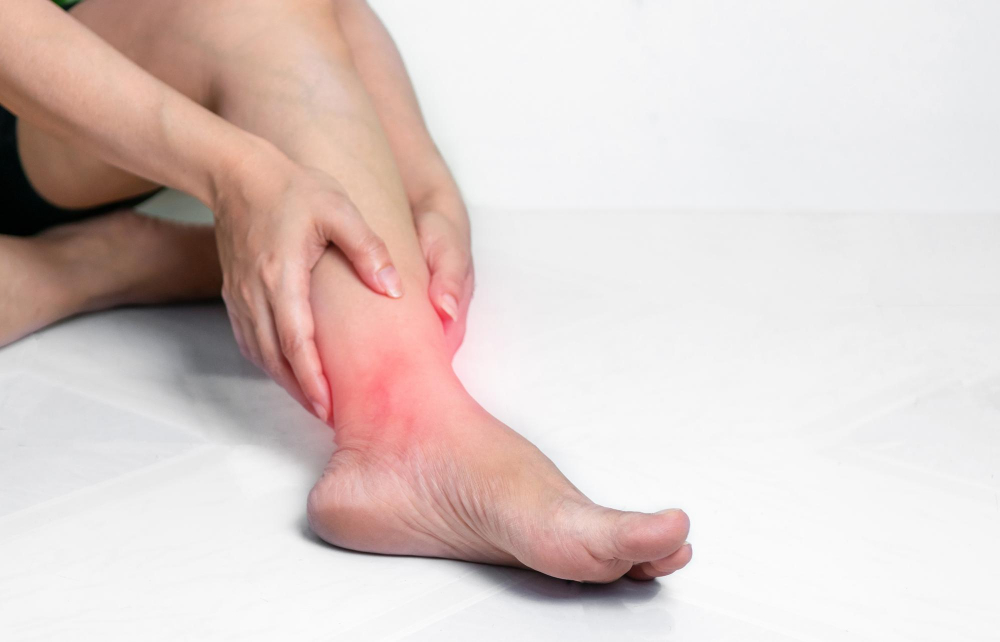An ankle sprain is a condition in which the ligaments supporting the ankle get stretched or torn. This can occur due to a variety of circumstances, including falling into a pit, twisting the ankle while walking or jogging, or placing weight on the leg in an unnatural position.
About Ankle Sprains
Ligaments are tough elastic bands of fibrous tissue. They stabilize the bones, connect one bone to another and prevent excessive movement. When an excessive amount of force is applied to the ligaments causing them to stretch beyond their normal limits and become damaged, it results in a sprain.
The most common type of sprain that occurs is the ankle sprain in which a ligament has been injured on the outer surface of the ankle. This injury may result in visible swelling and pain in the affected area. If the sprain is mild, the pain is mild. In the event of a severe ankle sprain, the swelling and pain are severe and the ankle may become restricted in movement. It may be difficult to bear the weight of the body on the affected leg.
Diagnosis
An ankle sprain can be diagnosed using an X-ray to get an image of the ankle’s internal structure. A bone scan is a procedure in which an intravenous radioactive substance is injected into the bone. The radioactive substance attaches to the damaged bone and is visible in the X-ray as bright spots. An MRI (Magnetic Resonance Imaging) scan uses radio waves and a strong magnetic field to get a good picture of the inner structure of your ankle. A Computerized Tomography (CT) scan is used to get cross sectional pictures of your ankle.
Treatment
For the initial management of a sprained ankle, you can follow the RICE approach.
R stands for Rest: rest your ankle properly and use some crutches if needed.
I stands for Ice: ice packs should be used for at least 3 days after the injury.
C stands for Compression: compressing your ankle with an elastic bandage helps prevent bruising and swelling.
E stands for Elevation: elevate your ankle above heart level for 2-3 hours every day.
The elastic bandage should be wrapped around your foot in a figure ‘8’ pattern, leaving your ankle exposed. Don’t wrap the bandage so tight that the blood flow stops. This wrap can be left on for up to 7 days.
Use appropriate medications to reduce swelling and physical therapy may be given once the swelling comes down. This increases the flexibility, balance, motion and strength of the ankle. In order for the ankle joint to heal properly, it may be necessary to wear a cast or walking boot. Surgery is needed for ligament tear.
Right way to use ice pack
Ice should be placed on the affected area of the ankle no more than 20 minutes at a time. The ice should be removed as soon as the ankle feels numb. Use ice once every 2-4 hours for the initial 3 days after the sprain. You can make an ice pack by crushing ice and putting it into a plastic bag. For a great ice massage, ice is first frozen in 4 to 8 ounces of Styrofoam cup. The top part of the cup should be torn off to reveal the ice. The ice should then be massaged on the affected area for a minimum of 30 seconds. For an ice slush bath, the bucket must first be filled with ice water and then submerge your ankle in the water until it becomes numb.
Preventing re-injury
To prevent reinjury, you need to exercise your ankle to strengthen the muscles. You will need a semi rigid ankle brace for 1-2 months to prevent further ankle sprains. To exercise your ankle, you will need to make circles with your ankle while you are sitting on the ground with your legs stretched. You can make around 5-10 circles three times a day moving your ankle up, down, and side-to-side. You can write alphabet letters in the air using your toe. You can also pull your toes towards yourself and point them away and hold this position for 15 seconds. You can do this about 10 times a day. Other exercises include sitting and standing heel raise, to improve your balance, you can also stand on your injured leg for about 30 seconds and gradually increase the duration. Place a chair in front of you to provide support.
Returning to sports
The ability to resume sports activities depends on the extent of the injury. For activities like swimming and biking, you can go back to them right away, as long as you don’t feel any pain. For other sports, make sure you’re wearing an ankle brace support at all times. To avoid an ankle sprain always wear shoes that fit correctly, warm up before doing any sports activity, and don’t exercise on uneven surfaces.



